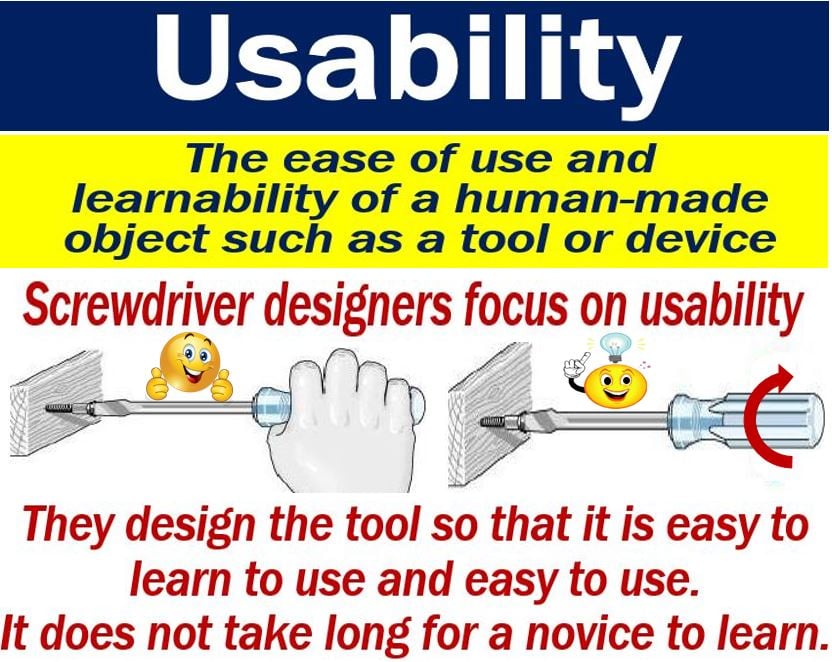What is usability? Definition and examples
Usability is the degree to which we can use something. It is also the degree to which something is fit for us to use. Usability is the intuitiveness, speed, and ease in operating or using a product, service, or facility.
The term is all to do with ease of access, i.e., accessibility. It is also about how hard or easy something is to use.
Put simply; the term refers to how usable something is.
The International Standardization Organization (ISO) says that usability is the extent to which specified users can use something. Specifically, use something to achieve specific goals with efficiency, effectiveness, and satisfaction.
The ISO’s exact words are:
“The extent to which a product can be used by specified users to achieve specified goals with effectiveness, efficiency, and satisfaction in a specified context of use.”

Screwdriver makers design their tools so that the handle has rounded edges and a graspable surface. These features make it easier to hold and use the tool. The tool has a simple design. Learning how to use it is straightforward. (Image: adapted from Wikipedia)
Etymology of usability
Etymology is the study of where words come from, i.e., their origins. It is also the study of how words’ structures and meanings have evolved.
The word ‘usability’ is the noun for the adjective ‘usable.’ It comes from the word ‘usable.’
‘Usable’ first emerged in the English language in the late fourteenth century. It came from the Old French word ‘Usable’, which meant ‘available, in use.’
It was not a common English word before 1840.
The term ‘usability’ did not become popular until the last couple of decades of the twentieth century. It became a buzzword for software engineers and website designers.
In software engineering, the term refers to the degree to which specified consumers can use a computer program.
Usability vs. user experience
The term ‘usability’ is part of a broad field we call ‘user experience.’ However, it differs from ‘user experience,’ because it does not consider utility or usefulness directly. In economics, utility refers to how much satisfaction or pleasure people derive when they consume something.
Let’s look at the difference between the two terms:
User experience
‘User experience’ is all about users’ subjective feelings. It refers to users’ attitudes regarding using something.
The term ‘user experience’ includes the product’s functional scope, psychological expectation, and product brand. It also includes the actual emotional feeling of the user.
We can use the term ‘user experience’ for services and systems as well as products.
User experience has four elements:
- Desirability: When I used the product, did I have fun, did I enjoy it? Was it engaging?
- Usability: How easy or difficult was it to accomplish tasks?
- Value: As far as I am concerned, does this product provide any value?
- Adaptability: How well will this product catch on, i.e., will people start using it?
Usability
This is all about how effective something is. The degree to which something is easy to learn and easy to use, i.e., how ‘user friendly’ it is.
Usability also looks at how efficient and error-free something is. It also looks at user satisfaction.
MockPlus.com says that usability has four elements:
- Flexibility: can the product do anything else, apart from accomplishing its task? In other words, apart from doing what it is supposed to do, what else can it do?
- Functionality: does the product do what it is supposed to do? Does it function normally?
- Learnability: can I use it now without having to undergo any extra learning?
- Industry Design: do I like how it looks? Does it look nice?
Video – Usability
This video explains what user experience, user experience design, and usability are.

